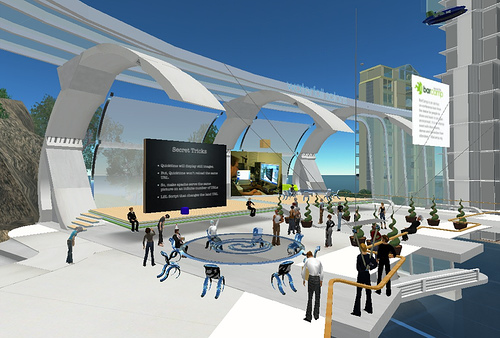Tuesday, 6 November 2007
Second Life
Second Life is a 3-D virtual world entirely created by its Residents. Since opening to the public in 2003, it has grown explosively and today is inhabited by millions of Residents from around the globe.
From the moment you enter the World you'll discover a vast digital continent, teeming with people, entertainment, experiences and opportunity. Once you've explored a bit, perhaps you'll find a perfect parcel of land to build your house or business.
You'll also be surrounded by the Creations of your fellow Residents. Because Residents retain the rights to their digital creations, they can buy, sell and trade with other Residents.
The Marketplace currently supports millions of US dollars in monthly transactions. This commerce is handled with the in-world unit-of-trade, the Linden dollar, which can be converted to US dollars at several thriving online Linden Dollar exchanges.
out of: http://secondlife.com/whatis/
Second Life
A lot of other real-world businesses are paying attention. That's because virtual worlds could transform the way they operate by providing a new template for getting work done, from training and collaboration to product design and marketing. The British branding firm Rivers Run Red is working with real-world fashion firms and media companies inside Second Life, where they're creating designs that can be viewed in all their 3D glory by colleagues anywhere in the world. A consortium of corporate training folks from Wal-Mart Stores (WMT), American Express (AXP), Intel (INTC), and more than 200 other companies, organized by learning and technology think tank The MASIE Center in Saratoga Springs, N.Y., is experimenting inside Second Life with ways for companies to foster more collaborative learning methods. Says Intel Corp. learning consultant Brent T. Schlenker: "We're trying to get in on the front end of this new workforce that will be coming."

Second Life
BBC launches 'Second Life for kids'
The BBC is to launch a children's version of the cult virtual world, Second Life.
CBBC World will offer youngsters a safe environment to explore, and provide them with different zones offering CBBC content.
The project is one of the keystones of BBC Children's move to become truly cross-platform.
As in Second Life, children will be able to create virtual versions of themselves on-screen, called avatars. Their characters can then move around CBBC World.
There they will also be able to take part in games, animations, videos and music, create their own content and send their work to other CBBC World users.
Children can also upload their work on to a gallery and the best will be used on the CBBC TV channel.
...
to read the full article, please visit:
Tuesday, 30 October 2007
Exam Paper
The whole of the net in your hand
[…]
Pattern recognition
The numbers of mobile phone users accessing the web is growing steadily. The most recent figures available, for February 2007, from the Mobile Data Association show that almost 15 million people use the web via their handsets each month.
T-Mobile was the first in the UK to bring in a flat-rate pricing plan for net use under the banner of its "web and walk" service.
Richard Warmsley, head of internet on the move at T-Mobile, said more than 500,000 people had signed up to "web and walk" in the 18 months since it was launched.
Lifestyle changes and the increasingly connected lives of 21st Century Britons was driving many people to use the service, he said.
"Usage is as diverse as the people using it," he said.
Increasingly, he said, what people do on a PC they want to do on a phone too.
"Social networking has rocketed up the charts recently," he said. Sites such as Bebo, MySpace, Facebook and eBay have become very popular destinations for customers.
"Half of our customers surf the internet on their mobile when they are at home watching TV," he said. "They do not need to go to a laptop and fire it up. The mobile is there for them."
[…]
Flat rate prices, accelerating mobile data speeds, increasing numbers of handsets that are web capable and the tearing down of the walls around operators' portals have all helped to "liberate usage" among customers.
UK MOBILE DATA PLANS
Vodafone - £7.50 a month (120MB monthly limit)
T Mobile - £7.50 a month (1GB monthly limit)
Orange - £8 a month (30MB monthly limit)
3 - £5 a month (1GB monthly limit)
02 - £7.50 (200MB monthly limit)
[…]
Statistics gathered by Novarra show that open web browsing boosts data downloads from an average of 0.18 megabytes per day to 0.6.
Operators had started to realise too that, for many, the mobile phone is the gadget they carry with them all day and may become the preferred way to access the net.
[…]
Questions
The questions 1, 2 and 3 can be answered mainly by reference to the article.
Question 4 should be answered by making detailed reference to examples from your case study material to support points made in your answer.
1) State 3 pieces of statistical evidence from the passage which indicate the extent of people using the web via their mobile phone.
2) What do the operators have to consider when making offers?
3) What caused people using their mobile phone for accessing the web?
4) How influential is New Media Technology on the future of the advertising industry?
Good luck! :-)



